|
DURABOOK Z14I original vs new
|
|
|
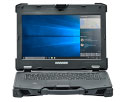
|

|
|
DURABOOK model
|
Z14I (2019)
|
Z14I (2022)
|
|
Weight
|
7.9 lb
|
7.9 lb
|
|
Intel Processor
|
8th generation
|
11th generation
|
|
Graphics
|
Intel UHD
|
Intel Iris Xe
|
|
Discrete Graphics
|
opt. Nvidia GTX 1050
|
opt. Nvidia GTX 1050
|
|
Standard Storage
|
Hard disk
|
PCIe NVMe SSD
|
|
Optional Storage
|
SATA SSD
|
SATA SSD
|
|
Max Battery capacity
|
84.2 + 50.8 watt-hours
|
84.2 + 50.8 watt-hours
|
|
USB Type-A
|
2 x USB 3.1, 1 x USB 2.0
|
1 x USB 3.2 Gen 1, 1 x USB 3.2 Gen 2, 1 x USB 2.0
|
|
USB Type-C
|
1 x USB 3.1
|
1 x USB 3.2 Gen 2 with DP
|
|
Thunderbolt 4
|
No
|
Yes
|
|
Wi-Fi
|
AC 9260, 802.11ac
|
Wi-Fi 6 AX201
|
|
Bluetooth
|
Bluetooth 5.0
|
Bluetooth 5.2
|
|
Drop spec
|
6 feet
|
6 feet
|
|
Sealing
|
IP65
|
IP65
|
|
Starting price
|
US$3,599
|
US$3,599
|
The table to the right shows a spec comparison between the original DURABOOK Z14I that was launched in 2019, and the updated 2021 version. Right upfront: what the company did was give its field-proven fully rugged machine a big tech update: newer and faster processors, more and faster memory, much faster primary storage, faster wired and wireless communication, Thunderbolt 4 and more.
There was no need for changing the overall design of the Z14I. Though a very rugged machine, it has all the conveniences and features of a consumer notebook: a clean, logical full-size keyboard, up to a terabyte of either hard or solid state disk (and much more with an optional secondary and tertiary drive), space for a Super Multi DVD drive if required, a wealth of card readers (microSD Card, Smart Card, SIM, ExpressCard or PC Card), enough memory (up to 64GB of fast 3200mHz DDR4), and plenty of onboard connectivity both wired and wireless.
Durabook has a history of making sure to always offer customers the latest available Intel processors. That's not easy given Intel's rapid-fire release of new generations. As is, the DURABOOK Z14I comes with the choice of one of four Intel "Tiger Lake" 11th generation Core i5 and i7 CPUs. Our review unit was equipped with a Core i7-1165G7 quad-core vPro processor. This puts the DURABOOK Z14I right alongside its primary competition in the rugged laptop arena.
The DURABOOK Z14I is a very tough machine. It uses heavy-duty aluminum-magnesium for its hefty chassis and part of the exterior, very solid display hinges, and a fully integrated carry-handle. It feels way more solid than any semi-rugged, let alone any consumer laptop. All ports and slots are behind protective doors. Unlike semi-ruggeds, the Z14I is pretty much a fully sealed machine. It can handle far more than just the spills and rain which are semi-rugged designs' limit.
And unlike in semi-rugged designs, there are no ventilation slots and other unsealed openings. That means no noisy fan that might fail or leak. That's what fully-rugged means, superior protection and virtually total immunity to the elements.
Design, look, and feel — purposeful and remarkably elegant
The product photography compilation below shows the DURABOOK Z14I from the top and all four sides. It's an undeniably attractive design that looks good on pictures and even better in person. The strong aluminum-magnesium alloy chassis and bottom mean the computer doesn't creak and twist like most plastic-based consumer laptops. The body of the Z14I is black, the top of the LCD case is a dark matte silver-gray with a powder-coat finish, black accents, and a designated logo area (Durabook machines often sell in rebadged versions). The top of the LCD case is contoured to add extra stiffness.
Much like the semi-rugged S14I model, the fully-rugged Z14I perfectly projects the tough tool-for-the-job look common to most heavy-duty rugged notebooks. The strong LCD hinges offer good resistance when opening and closing the computer. When closing the laptop, a spring-loaded latch snaps into place, securing the LCD when in closed position. To open the notebook again, you push a spring-loaded lock.
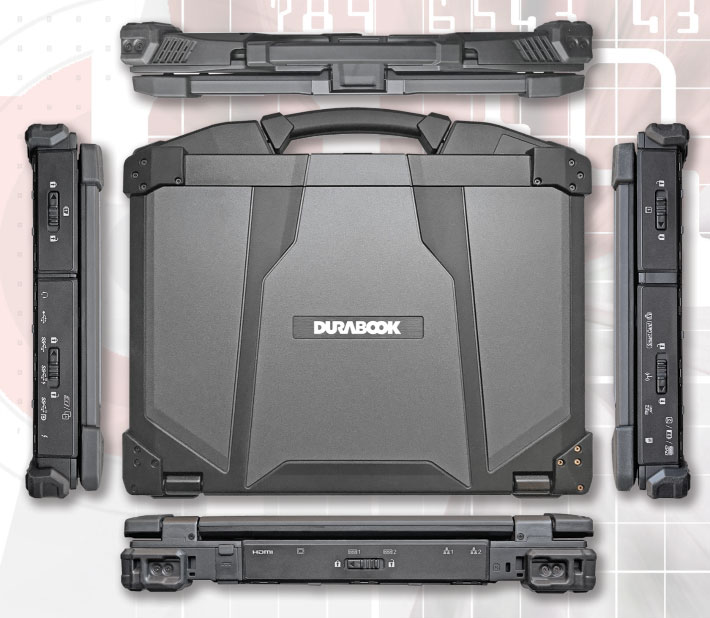
Ports and connectivity are placed on the left, right and back sides of the laptop. The ports on each side are located behind hinged plastic covers with sliding locks that protect against physical damage and are also designed to provide full protection against dust and liquids. All covers are screwed on and, if need be, replaceable.
The two pictures below show a more detailed view of the left and right side of the DURABOOK Z14I.
On the right side (top picture), from left to right, first is the compartment for the main battery. To the right of that is a large double-decker I/O area that on the upper level has an ExpressCard card slot (optional a PC Card Type II slot); and on the lower level an audio combo jack, a USB 2.0 Type A port, two USB 3.2 Type A ports (one of them supports charging even when the computer is off), a USB 3.2 Type C port (supports DP), and a Thunderbolt 4 port.
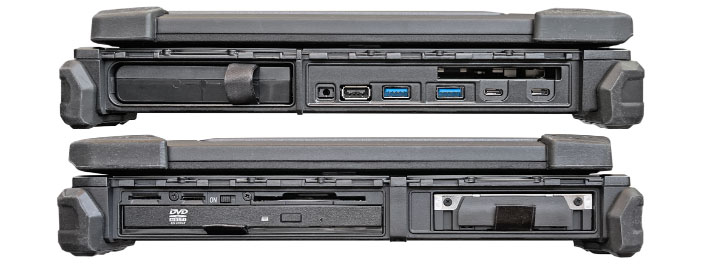
On the left side is the storage drive compartment that holds the quick-release solid state disk caddy for up to two SSD drives. Next to it another large double-decker I/O area with, on top from left to right, a SIM card slot, a microSD card slot, a slider that turns all radios on or off, and a Smart Card reader. Below that is a bay that can accommodate either an optical disk drive, a secondary battery pack, or a tertiary storage caddy.
On the back of the machine is the power jack, then another large I/O area with, again from left to right, an HDMI port, a VGA port, two legacy DB9 RS232 serial ports, and two RJ45 LAN jacks. Next to that is a Kensington-compatible physical lock slot. Yes, physical security remains important.

Below is what the DURABOOK Z14I looks like from the bottom. On the left is the unit fully assembled. Note the substantial rubber corner guards that provide protection and also a sure footing for the laptop. There is a grand total of eight of them, each screwed on and easily replaceable. On the right is a look at the underside of the Z14I with its bottom corner guards removed abd its three major I/O compartment doors open. Note how each port is clearly labeled with white-on-black description or icon.
What you don't see are access doors to module (i.e. RAM, WWAN, WLAN, GPS, storage, etc.) compartments. There aren't any. Those modules are accessed from the top instead. That way those modules can be accessed even when the Z14I is bolted onto its optional expansion chassis.
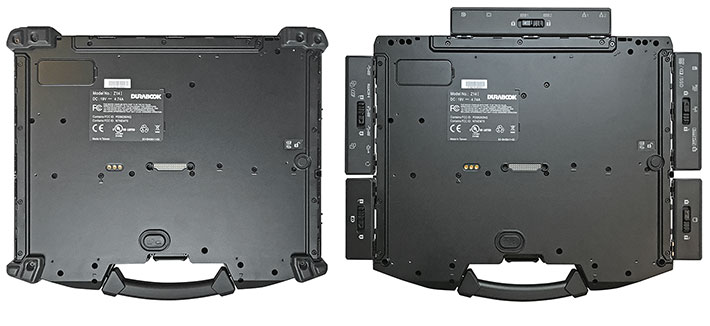
So how can you get to the two RAM memory slots and the other expansions lots? That's not immediately obvious. They are all located underneath the keyboard, and to access them you first have to flip open the keyboard. That requires taking off the plastic hinge and function button cover (four small screws), then carefully flipping the keyboard over, and removing the screws that hold the two module compartment covers in place. Keep track of the two keyboard ribbon cables that must be firmly seated in their respective connectors.
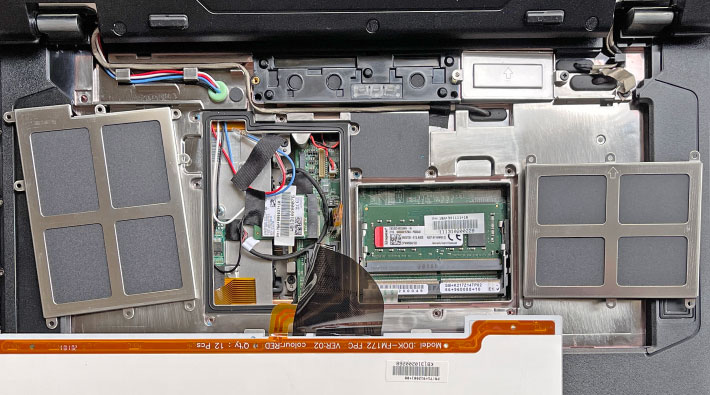
We generally open up all review units that pass through the RuggedPCReview.com test lab. That's because ruggedness starts inside. A good rugged unit is built rugged from the ground up. With most laptops, the bottom of the unit comes off and affords a full look at at the insides. The DURABOOK Z14I's designers, however, took a dfferent approach, one where all electronics sit in the strong system box and it is the keyboard side that comes off.
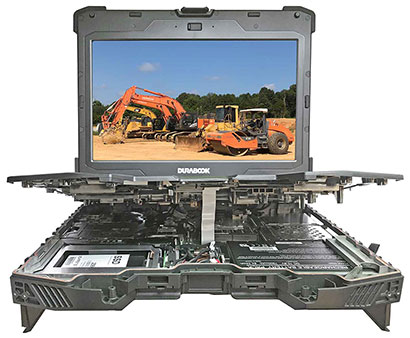 This type of the design actually makes a lot of sense as it provides a structurally very strong basis, in essence a box with a top that comes off. The drawback when opening up the unit is that there are usually ribbon and other cables between the electronics and the keyboard top of the unit.
This type of the design actually makes a lot of sense as it provides a structurally very strong basis, in essence a box with a top that comes off. The drawback when opening up the unit is that there are usually ribbon and other cables between the electronics and the keyboard top of the unit.
We decided to try anyway and undid the fairly large number of screws that hold the big, tough Z14I together.
However, we chose not to separate all the cables on top and fully separate the halves. Instead, we opened the clamshell just enough to take a good peek inside. The seal between the bottom cage and the polymer plastic top is via a tongue-and-groove design with a replaceable orange seal.
We also got a glimpse of the copper tubing that syphons heat off the processor and ancillary electronics and disseminates it into the thick and heavy aluminum-magnesium bottom of the laptop. This works remarkably well; even without a cooling fan, the big DURABOOK barely heated up.
Most laptop users are used to fans as a necessary nuisance, but it is so nice not to have a noisy fan that blows hot air.
The pictures below were taken with our FLIR One Pro infrared camera while the Z14I was running a benchmark. The bright yellow areas is where the DURABOOK heated up most. This new model with an Intel 11th generation Core processor ran somewhat hotter under load than the one we tested with the older 8th gen chip, possibly due to Intel now allowing manufacturers to custom-configure running modes. Still, it's amazing how much heat a heavy metal chassis can soak up, spread, and disseminate. Keeping temperatures reasonably low has a direct impact on overall systems performance. That's because maximum achievable processor "turbo" clock speeds depend on temperature readings.
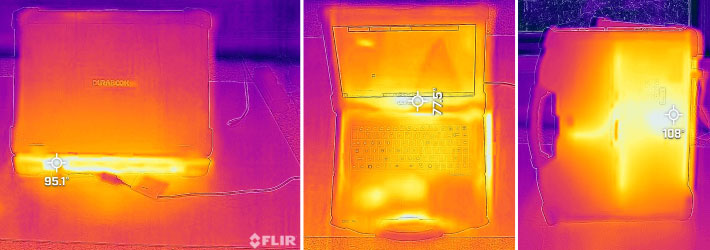
Also interesting is the Z14I's internal construction with numerous daughterboards providing services to the mother board. This type of design provides room for customization, easy replacement of modules, and easy tech updates.
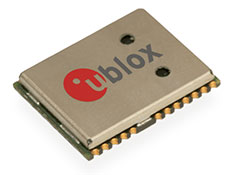 Our review unit came with a ublox NEO-M8N concurrent GNSS module. A great feature of the M8N is that it can track up to three of the four available GNSS systems concurrently, those being GPS (the US system), GLONASS (the Russian version of GPS), the European Galileo, and the Chinese BeiDou. The ability to track three of those systems means potentially triple the number of available satellites, making for quick starts, very good accuracy, and superior coverage.
Our review unit came with a ublox NEO-M8N concurrent GNSS module. A great feature of the M8N is that it can track up to three of the four available GNSS systems concurrently, those being GPS (the US system), GLONASS (the Russian version of GPS), the European Galileo, and the Chinese BeiDou. The ability to track three of those systems means potentially triple the number of available satellites, making for quick starts, very good accuracy, and superior coverage.
The DURABOOK Z14I has two SODIMM RAM slots. Our review machine came with two 8GB DDR4 Innodisk sticks. The two PCIe M.2 expansion sockets of our tester were used for WiFi (an Wi-Fi 6 AX201 802.11 ax with Bluetooth 5.2 in our unit) and optional WWAN (ours had a Sierra Wireless AirPrime MC7355). Both have prewired antenna leads.
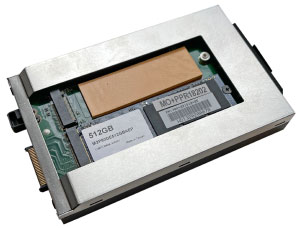 Mass storage is located inside a black plastic box with a metal cover that fits flush into the left side of the unit. The basic standard configuration of the DURABOOK Z14I comes with a 256GB NVME PCIE SSD for primary storage, with up to 1TB available. That makes for a big performance improvement compared to the SATA III SSD the predecessor version came with. The Z14I can also accommodate optional secondary and even tertiary storage, albeit of the slower SATA SSD variety.
Mass storage is located inside a black plastic box with a metal cover that fits flush into the left side of the unit. The basic standard configuration of the DURABOOK Z14I comes with a 256GB NVME PCIE SSD for primary storage, with up to 1TB available. That makes for a big performance improvement compared to the SATA III SSD the predecessor version came with. The Z14I can also accommodate optional secondary and even tertiary storage, albeit of the slower SATA SSD variety.
When we reviewed the launch version of the Z14I, we noted that it was likely the last time we'd see room for a 2.5-inch rotating disk in a new design, and that we hoped Durabook would soon make PCIe-based mass storage available. Both came true in this new version.
As is, the mass storage caddy, which now has two storage slots, is designed to quickly be removed from the laptop. That is often a requirement in enterprise and government settings. The caddy is locked and unlocked via a friction lever. It is not likely to come lose unintentionally.
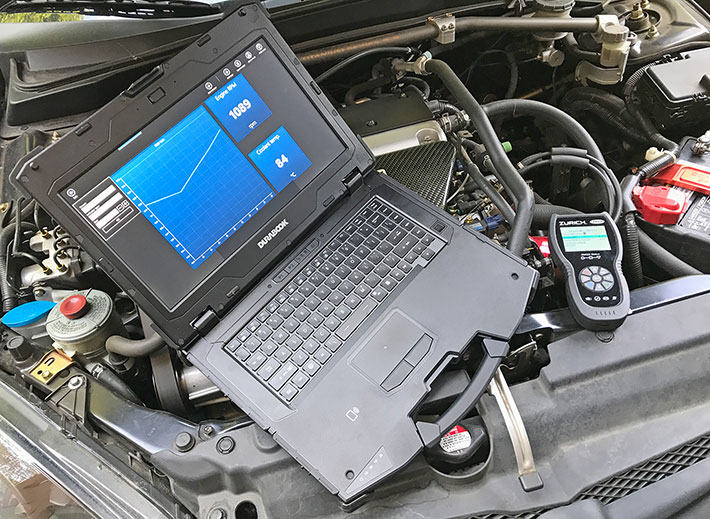
Keyboard and touch pad — pleasant
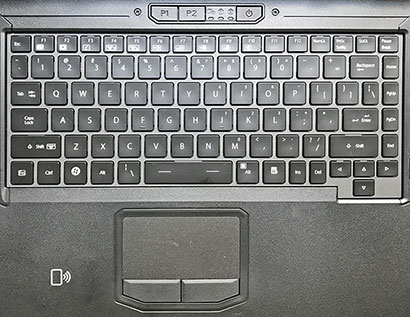 The DURABOOK Z14I's keyboard is full-scale and has 88 keys. The key design is standard "island" style with flat keys and minimal travel but good tactile feedback, as is common in today's notebooks and even desktop keyboards.
The DURABOOK Z14I's keyboard is full-scale and has 88 keys. The key design is standard "island" style with flat keys and minimal travel but good tactile feedback, as is common in today's notebooks and even desktop keyboards.
The central QWERTY layout is 100%-scale, which means the distance between the center of the Q key on the left and the P key on the right is 6.75 inches. That makes it perfect for touch typists. The keys are black with white letters, numbers and symbols. Optionally available is an LED keyboard backlight with brightness adjusted via function keys.
Below the keyboard is the unit's capacitive touch pad. It is a properly sized (not too small, not too large) touch area with a slight frame around it so your fingers feel the extent of the pad, and with two large mouse buttons in front of it. The mouse buttons require a relatively firm press and issue an audible mechanical click. The touch pad is very responsive and easy to use, and it can even be operated with gloves on (as long as they are not too thick).
Above the keyboard are two programmable function buttons, three status indicator lights (disk activity, numlock, capslock), and then power/sleep button.
Performance: state-of-the-art processor technology
In the past, rugged laptops with their longer purchase and lifetime cycles often lagged behind consumer products in terms of technology and performance. That made sense as durability, reliability and compatibility were deemed more important than frequent updating to the latest standards. Over the past few years, however, competition has heated up and state-of-the-art technology has become a strategic advantage as well as a necessity.
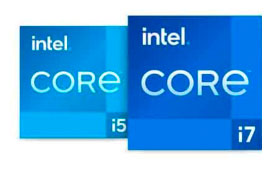 As of this writing (early November 2021), of the fully rugged laptop competition, the Dell 7330, Winmate L140TG, Emdoor EM-X33 (an OEM design) are at the 11th generation of Core processors; the Getac B360 and B360 Pro, the DT Research LT330, and Panasonic Toughbook 33 at the 10th generation; the Panasonic Toughbook 31 still at the 7th generation.
As of this writing (early November 2021), of the fully rugged laptop competition, the Dell 7330, Winmate L140TG, Emdoor EM-X33 (an OEM design) are at the 11th generation of Core processors; the Getac B360 and B360 Pro, the DT Research LT330, and Panasonic Toughbook 33 at the 10th generation; the Panasonic Toughbook 31 still at the 7th generation.
Overall, there haven't been very large changes in the last few generations of Intel's Core processors. It's complex and expensive to make transistors smaller and smaller, and so Intel has spent much time fine-tuning and optimizing their chips instead over the past several years. There have been a number of milestones such as leaving Windows 7 behind with the "Kabey Lake" 7th generation, making mobile quad-core chips available in the "Coffee Lake" 8th generation, and now we're seeing another in the "Tiger Lake" 11th generation used in the DURABOOK Z14I. and the reason may be different from what one might expect.
Before we get into that, here's a list of all the processor options available for the DURABOOK Z14I (to view the full Intel spec table for these Four CPUs, see here):
|
2021 DURABOOK Z14I: Available Intel Core processor options
|
|
Available Z14I CPUs
|
Intel Core i7
|
Intel Core i7
|
Intel Core i5
|
Intel Core i5
|
|
Model
|
1185G7
|
1165G7
|
1145G7
|
1135G7
|
|
Cores/Threads
|
4/8
|
4/8
|
4/8
|
4/8
|
|
Base Clock Speed
|
1.20 GHz
|
1.20 GHz
|
1.10 GHz
|
0.90 GHz
|
|
Turbo Speed
|
4.80 GHz
|
4.70 GHz
|
4.40 GHz
|
4.20 GHz
|
|
TDP-up
|
28 watts, 3.00GHz
|
28 watts, 2.80GHz
|
28 watts, 2.60GHz
|
28 watts, 2.40GHz
|
|
TDP-down
|
12 watts, 1.20GHz
|
12 watts, 1.20GHz
|
12 watts, 1.10GHz
|
12 watts, 0.90GHz
|
|
Smart Cache
|
12MB
|
12MB
|
8MB
|
8MB
|
|
Integrated graphics
|
Iris Xe
|
Iris Xe
|
Iris Xe
|
Iris Xe
|
|
Graphics max speed
|
1.35 GHz
|
1.30 GHz
|
1.30 GHz
|
1.30 GHz
|
|
Graphics Execution Units
|
96
|
96
|
80
|
80
|
|
Relative CPU cost
|
1.53
|
1.53
|
1.10
|
1.10
|
|
Intel Stable Image Platform Program
|
Yes
|
No
|
Yes
|
No
|
|
Intel TSX-NI
|
Yes
|
No
|
Yes
|
No
|
|
Intel Trusted Execution
|
Yes
|
No
|
Yes
|
No
|
|
Intel vPro
|
Yes
|
No
|
Yes
|
No
|
The top processor option for the DURABOOK Z14I is the Intel Core i7-1185G7. This high-end chip offers the highest maximum turbo frequency as well as the highest frequencies at the 28 watt and 12 watt TDP-Up and TDP-down settings. Next in line is the Core i7-1165G7 (installed in our review unit). It is a bit slower overall and doesn't include some of Intel's special technologies. Next are two Core i5 chips that have only 8MB instead of 12MB SmartCache, fewer graphics execution units, as well as small clock frequency and included Intel technology differences.
When deciding on a processor option for the Z14I, what may make a difference in certain applications is the availability of four special Intel technologies (vPro, TME, SIPP, and Trusted Execution) see here.
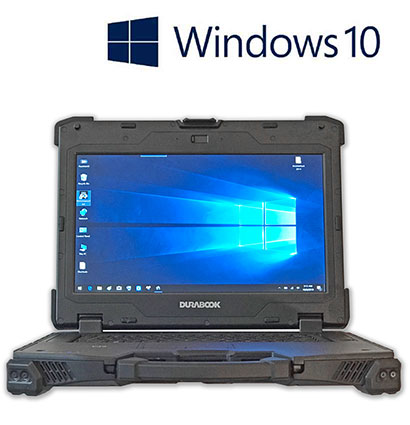 Here's what that means:
Here's what that means:
- The extra security and manageability capabilities of vPro, especially, are required in many enterprise deployments.
- TME (Total Memory Encryption) ensures that all memory accessed from the CPU is encrypted, including customer credentials, encryption keys, and other IP or personal information on the external memory bus.
- SIPP (Stable Image Platform Program) allows deployment of standardized, stable image PC platforms for at least 15 months, and
- Trusted Execution technology provides security capabilities such as measured launch and protected execution, and may thus also be an enterprise requirement.
To see what kind of performance the new quad-core DURABOOK Z14I can achieve, we ran our standard benchmark suites, Passmark Software's PerformanceTest version 6.1 and 9.0, CrystalMark, as well as PC Mark 10, GeekBench 5 and one of the most often used 3DMark graphics benchmarks, Time Spy.
For comparison and to provide an idea where the upgraded Z14I stands compared to Durabook's own (and also upgraded) semi-rugged S14I, we included benchmark results of the rugged and semi-rugged competition from Getac, Dell, DT Research and Panasonic.
The results are as follows:
|
DURABOOK Z14I Benchmarks and Comparisons
|
|
Manufacturer
|
Durabook
|
Durabook
|
Getac
|
Getac
|
Getac
|
Dell
|
DT Research
|
Panasonic
|
|
Model (year tested)
|
DURABOOK Z14I
|
DURABOOK S14I
|
K120 (2021)
|
S410 (2021)
|
B360 (2020)
|
Latitude 7424 (2019)
|
LT330 (2021)
|
TOUGHBOOK 55 (2021)
|
|
Ruggedness
|
fully
|
semi
|
fully
|
semi
|
fully
|
fully
|
semi
|
semi
|
|
CPU Type: Intel
|
Core i7
|
Core i7
|
Core i7
|
Core i7
|
Core i7
|
Core i7
|
Core i7
|
Core i7
|
|
CPU Model and gen
|
1165G7 (11th)
|
1165G7 (11th)
|
1165G7 (11th)
|
1185G7 (11th)
|
10710U (10th)
|
8650U (8th)
|
10710U (10th)
|
1185G7 (11th)
|
|
Thermal Design Power (TDP)
|
12/28 watts
|
12/28 watts
|
12/28 watts
|
12/28 watts
|
15 watts
|
15 watts
|
15 watts
|
12/28 watts
|
|
Thermal Management
|
fanless
|
fan
|
fan
|
fan
|
fan
|
fan
|
fanless
|
fan
|
|
BatteryMon min draw
|
6.1 watts
|
5.5 watts
|
2.8 watts
|
3.8 watts
|
2.2 watts
|
5.2 watts
|
3.7 watts
|
3.3 watts
|
|
PassMark 9.0
|
4,800.2
|
5,164.5
|
5,839.5
|
5,637.2
|
4,531.8
|
3,913.7
|
3,948.8
|
4,964.8
|
|
CrystalMark
|
463,662
|
455,646
|
522,217
|
488,622
|
333,057
|
312,288
|
336,613
|
503,390
|
|
PCMark 10
|
4,623
|
4,570
|
5,148
|
4,876
|
4,265
|
NA
|
NA
|
4,904
|
|
3DMark Time Spy
|
1,232
|
1,040
|
1,434
|
1,579
|
1,520
|
NA
|
NA
|
1,160
|
|
GeekBench 5
|
1,391
|
1,496
|
1,531
|
1,545
|
1,238
|
NA
|
NA
|
1,484
|
What do these numbers show? Overall, that Intel's "Tiger Lake" 11th generation of Core processors really is a milestone platform, even compared to the last such milestone — the 8th generation of Core processors that pioneered quad-core designs for Wintel mobile platforms. "Tiger Lake" machines easily outperform anything that came before.
As for comparing performance among these high-end rugged and semi-rugged laptops, there is remarkable parity. One machine may have a small edge over another in this benchmark, another machine in that benchmark. There may be small differences attributable to the chosen processor option, the amount of RAM, the type and brand of mass storage, or systems configuration. But, by and large, there is performance parity. All the leading competitors have switched to the latest technologies and latest standards.
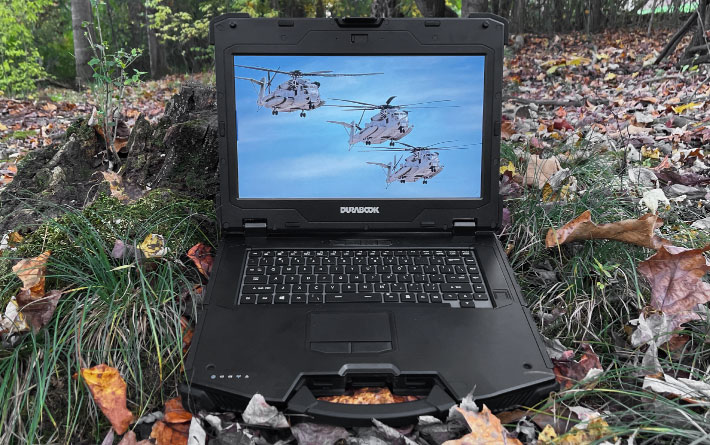
Compared to other 11th gen systems, the DURABOOK Z14I is different in one small but important respect: it is a fanless design whereas the competition uses an active fan as part of their thermal management. What are the arguments for or against a fan? Fans keep a system cooler and may therefore allow higher sustained peak performance than a faness system. On the other hand, fan noise can be distracting, a fan's air movement may be undesirable in some settings, and fans may get clogged or fail.
DURABOOK explains that "by nature, a fan-sink thermal solution provides better system heat dissipation capability compared to fanless solutions but at the same time compromising the ruggedness and protection that a fully enclosed system offers (against sand, dust, water). That's why their semi-rugged S14I has a fan and their fully rugged Z14I doesn't.
DURABOOK further explains that due to the differences in thermal design, the S14I is therefore able to sustain longer and higher CPU turbo boost compared to that of the fanless Z14I. For the S14I, we incorporated performance and power saving to extend battery life in one platform with an active thermal solution. For the fanless Z14I, we chose a more balanced approach in tuning the system with the best performance/power saving that the passive thermal solution can handle/offer."
In other words, when plugged in, the fan keeps the semi-rugged S14I cool enough to reach higher performance than the fanless Z14I. But unplugged, they configured the semi-rugged S14I to run a bit slower so it doesn't use too much battery having the fan on all the time, whereas the fanless Z14I remains unthrottled. And that's exactly what we saw in our benchmark testing: The S14I runs 25-30% faster plugged in than on battery, whereas the fanless Z14I ran at virtually the same speed plugged in or on battery.
Interestingly, while DURABOOK's rationale and explanation makes perfect sense, and the big, rugged Z14I generates remarkably consistent performance plugged in or not, the processor itself behaves very differently. In the graph below, you can see that when plugged in, system clock speed is consistently at a very high level, whereas on battery it constantly flutters between high and low.
|
DURABOOK Z14I PCMark 10 CPU clock speed plugged in (top) vs on battery (bottom)
|
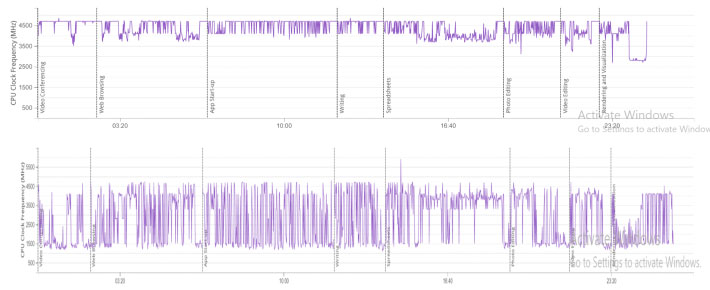
We asked Intel and their response was that the 11th generation of Core processors "provides our customers flexibility to design systems to their specific targets and needs and to optimize performance within the specific system environment and workload. That refers to Intel now allowing manufacturers to tinker with how fast the processors can run under what conditions, and how long they can stay at certain speeds before they need to trottle down to keep temperatures in check.
That makes sense. Manufacturers have now more leeway in tuning their systems and optimizing the ever crucial performance versus battery life balance for different modes of operation. Such as being plugged in or running on battery. The flipside is that the performance drop between plugged in and running on battery will be less predictable. Some drop off a lot, others very little. May this kind of dynamic tuning by manufacturers is still in its infancy. We'll keep monitoring the situation.
Power draw and battery life
It is one of the frustrations of modern life that mobile technology — the very tech that needs to be as small and light as possible — is also the tech that needs a battery that lasts as long as possible between charges. The proper sizing of laptop batteries, especially, is an exercise of give and take. A big battery makes for impressive battery life, but it comes at the cost of extra size and weight.
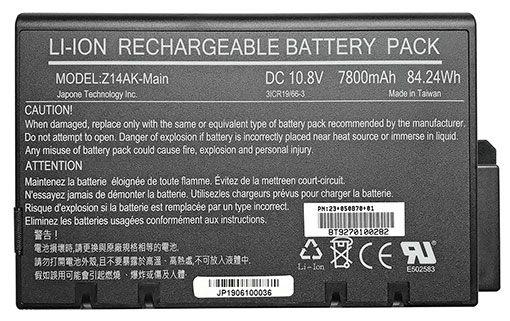 Weight, of course, matters with fully-ruggeds as it does with any other mobile computer, but not quite as much. This class of laptops usually weighs 7-9 pounds, and a bit more or less doesn't make that much of a difference. So with the Z14I, Durabook went with a big 84 watt-hour battery that weighs a pound all by itself.
Weight, of course, matters with fully-ruggeds as it does with any other mobile computer, but not quite as much. This class of laptops usually weighs 7-9 pounds, and a bit more or less doesn't make that much of a difference. So with the Z14I, Durabook went with a big 84 watt-hour battery that weighs a pound all by itself.
And if that's not enough, there's an optional smaller secondary battery rated at 51 watt-hours. That goes into the expansion/media bay (in lieu of an optical drive or secondary storage) and brings combined battery capacity up to an impressive 135 watt-hours.
How long does the DURABOOK Z14I last on a charge of its primary battery? Is the optional second battery needed/advisable? As is our standard procedure, we used Passmark Software's BatteryMon power management benchmark utility to measure the laptop's power draw under various operating conditions.
First we set the Windows 10 power options to "Max Battery" and display brightness to its lowest setting. That way we saw an idle power draw of 6.1 watts. We then cranked the backlight up to 50%, and draw increased to 6.9 watts. Then we cranked brightness all the way up to 100% and saw 9.6 watts.
|
DURABOOK Z14I Power Draws (at idle)
|
|
Backlight level
|
Darkest
|
50%
|
Brightest
|
|
Max Battery
|
6.1 watts (13.8 hrs.)
|
6.9 watts (12.2 hrs.)
|
9.6 watts (8.8 hrs.)
|
|
Max Performance
|
7.2 watts (11.7 hrs.)
|
8.6 watts (7.4 hrs.)
|
16.6 watts (5.1 hrs.)
|
We then set the laptop to "Max Performance." At the lowest brightness setting we saw an idle power draw of 7.2 watts. At 50% brightness draw increased to 8.6 watts. And at the maximum standard brightness setting, electric draw reached 16.6 watts. Why such a big difference between the max battery and max performance settings? It's because maximum brightness in the max performance setting is considerably brighter than maximum brightness in the max battery setting.
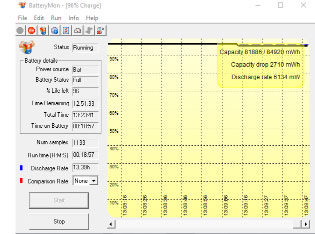 What do those power draw figures mean in terms of projected battery life? Equipped with just the standard battery, our review Z14I had a battery capacity of 84 watt-hours. Dividing that by the 6.1 watt minimum observed draw would indicate 13.8 hours of theoretical battery life with the system staying awake the whole time. In the maximum performance settings and the very bright maximum brightness, theoretical battery life would drop all the way to 5.1 hours.
What do those power draw figures mean in terms of projected battery life? Equipped with just the standard battery, our review Z14I had a battery capacity of 84 watt-hours. Dividing that by the 6.1 watt minimum observed draw would indicate 13.8 hours of theoretical battery life with the system staying awake the whole time. In the maximum performance settings and the very bright maximum brightness, theoretical battery life would drop all the way to 5.1 hours.
Realize that battery life estimates are entirely of the "your mileage will vary" kind. It all depends on settings, backlight brightness, and how the machine is used. The PCMark 10 Battery Test where the machine runs constantly varying typical tasks without ever even going to sleep yielded 9:41 hours.
Durabook's own estimate is 15 hours with the standard battery. That's within the margin of error compared with our 13.8 hour result. In this class of machine where weight usually is of lesser importance, unless an optical drive or secondary mass storage is absolutely needed, we'd suggest getting the secondary 51 watt-hour battery instead. It only adds about 10 ounces of weight, but several hours more running time.

Display — very bright and great reflection control
The DURABOOK Z14I's display measures 14 inches diagonally, which is standard for this type of laptop. Its 1920 x 1080 pixel resolution is much more pleasant to work with than the marginal 1366 x 768 that used to be the norm for rugged and semi-rugged laptops for years. 1920 x 1080 resolution makes for 157 pixels per inch, not high by smartphone or tablet standards, but well matched for Windows 10 on a laptop. 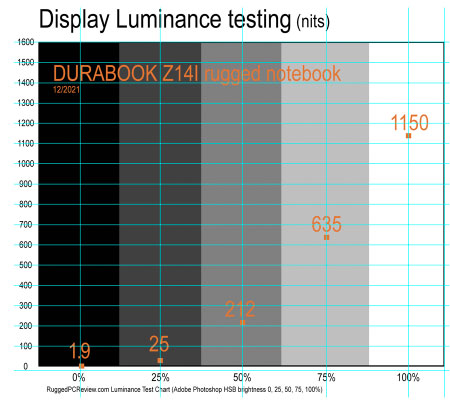
Whereas bright, outdoor-viewable displays are usually optional in semi-ruggeds, the fully-rugged Z14I comes standard with a brilliant DynaVueŽ display that's rated at 1,000 nits luminance. What's more, there are easily accessible stealth and night vision modes that may be required by some customers and agencies.
And since it may rain our there in the field, or it's cold and users wear gloves, the optional 10-point capacitive multi-touch Z14I display our review unit came with can be switched to finger/water, glove, or stylus only modes, or touch can be turned off altogether.
DURABOOK displays tend to exceed their stated nits ratings, and the Z14I's is no different. We used RuggedPCReview's luminance testing equipment and our custom luminance chart to see how bright the Z14I actually is. The test chart shows grayscale bands from 0% to 100% coverage in 25% increments.
As the image to the right shows, with a maximum recording of 1,150 nits the Z14I display significantly outperformed its 1,000 nits rating. Impressive.
The screen isn't just bright and vibrant and easily suitable for all all outdoor use; its surface is semi-matte, eliminating most of the annoying reflections common to most of today's consumer notebooks, and there seems to be a degree of anti-glare applied to it. The display in our eval unit, however, wasn't the same DURABOOK used in the original Z14I. That one had near perfect horizontal and vertical viewing angles without color and/or contrast shifts or brightness degradation when viewed from the sides. This new Z14I display did show such color and contrast variations at various viewing angles. We asked Durabook about it and the answer was that due to industry supply chain issues, they had to change the panel source. We hope the old IPS screen comes back at some point.
The picture below shows the Z14I outdoors on an average October day around noon. The display backlight wasn't even set to full brightness. The screen looks bright, vibrant and very readable, even with the above mentioned viewing angle issues.
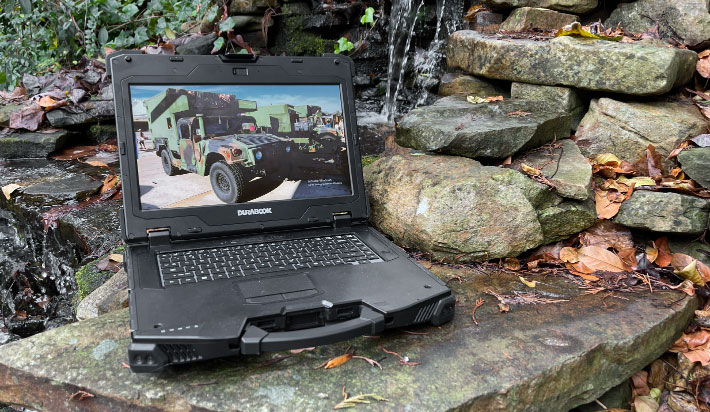
The images below shows the DURABOOK Z14I in typical light influx scenarios. The semi-matte display of the Z14I does not reflect; instead, it diffuses direct light and that results in the milkiness shown in one of the pictures below.
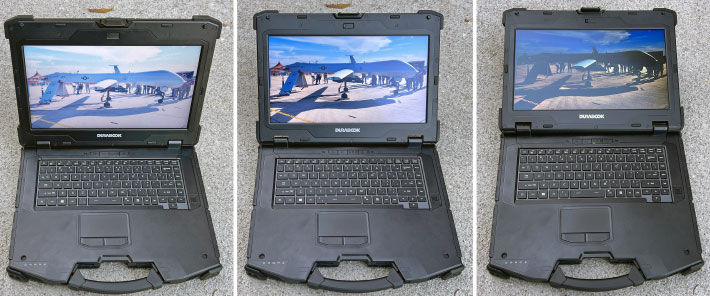
Overall, the DURABOOK Z14I display is good, but isn't as pleasant as the one in the predecessor model. It is very bright and contrasty indoors, and it remains very readable even in strong sunlight. Like some older DURABOOKs, the new Z14I's display suffered from viewing angle issues both horizontally and vertically, something we don't like to see. Users, however, will appreciate the full HD 1920 x 1080 pixel resolution of the default display.
Expansion and accessories
In the beginning of this review we mentioned Durabook president Joe Guest's statement of the Z14I having, in addition to a wealth of standard and optional I/O, "boundless customization options." 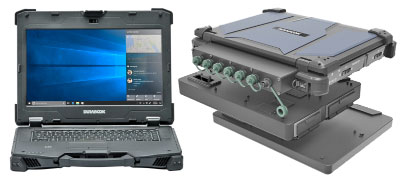 Customization, of course, is what sets the built-to-order approach often required by industrial markets apart from mass-produced consumer technology. Depending on the scope, customization can be done in various ways. Internal expansion bays, plug-in and bolt-on modules are examples used by various manufacturers.
Customization, of course, is what sets the built-to-order approach often required by industrial markets apart from mass-produced consumer technology. Depending on the scope, customization can be done in various ways. Internal expansion bays, plug-in and bolt-on modules are examples used by various manufacturers.
Durabook chose a multi-tiered approach that includes a) above-average onboard connectivity and onboard I/O options, b) dedicated office and vehicle docks, each of which adds additional comms/video ports and antenna pass-throughs, and c) a variety of expansion boxes that bolt onto the bottom of the laptop and communicate via a 41-point surface-mount docking port.
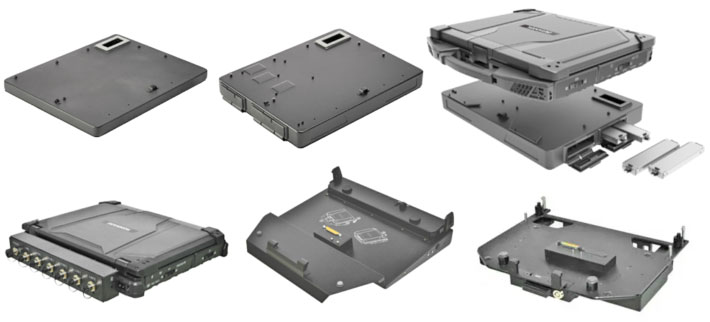
Durabook currently offers half a dozen of such expansion boxes that may provide functionality such as NVIDIA discrete video, military style connectors, PCI-Express slots, as well as different portable server configurations.
Thunderbolt 4
Almost every new laptop or tablet has a USB-C port these days. Unlike the original USB Type A port where the plug would only go in one way, the smaller USB-C port works no matter which way you plug it on. Not every USB-C port, however, is the same — it depends on what version and generation of the USB standard it supports.
To make matters a bit more confusing yet, a USB-C port may also be a Thunderbolt 4 port. Thunderbolt started as a joint effort between Intel and Apple, combining the PCI Express and DisplayPort signals. The latest version, Thunderbolt 4, uses the USB-C connector, supports charging upstream and downstream, USB 4 with very fast data transfer (up to 40 Gbit/s), as well as dual 4K displays. And the DURABOOK Z14I has one of those Thunderbolt 4 ports with a USB-C connector.
We gave the DURABOOK Z14I's USB-C Thunderbolt 4 port a workout and here's what we could do:
- Drive a 2nd screen via USB-C to DisplayPort cable
- Drive a 2nd screen via USB-C to HDMI cable
- Do very fast file transfers (we used the Anker cable as well as an Accell USB4 40Gbps cable)
- Drive and power an external DVD reader
- Use a USB key or card reader via USB-A to USB-C adapter
- Drive a mice and/or keyboard
- Charge a phone or tablet
Intel emphasizes that Thunderbolt 4 offers tablet and laptop users a true "one wire" solution. Here's the way that's envisioned: bring your tablet to the office and plug it into an external Thunderbolt 4 dock. That dock will then charge the tablet or laptop upstream and your phone(s) downstream, and also support a mouse, keyboard, USB keys, DVD drives, one or two external screens and whatever else you'd like to plug in. Just one cable needed, that between the tablet and the Thunderbolt 4 dock. No need to even use the tablet's power brick.
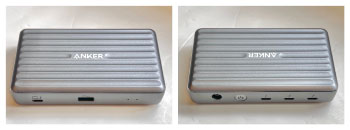 We put that to the test by connecting the DURABOOK Z14I to an Anker PowerExpand 5-in-1 Thunderbolt 4 Mini Dock, a handy 5 x 3 x 0.75 inch box with three powered USB Type-C downstream ports, a 10Gbit/s USB Type-A port, and an upstream port to connect to the computer that delivers 40 gbit/s data transfer, dual display support, and up to 85 watt charging power.
We put that to the test by connecting the DURABOOK Z14I to an Anker PowerExpand 5-in-1 Thunderbolt 4 Mini Dock, a handy 5 x 3 x 0.75 inch box with three powered USB Type-C downstream ports, a 10Gbit/s USB Type-A port, and an upstream port to connect to the computer that delivers 40 gbit/s data transfer, dual display support, and up to 85 watt charging power.
We tried the Anker dock with the DURABOOK Z14I and here's what we could do:
- Drive TWO extra screens via USB Type-C or HDMI cables
- Plug in USB docks
- Plug in USB keys
- Power and use an external DVD reader
- Connect mice and keyboards either through dock Type-A or Type-C ports
- Charges phones and tablets
- Upstream-charge the laptop
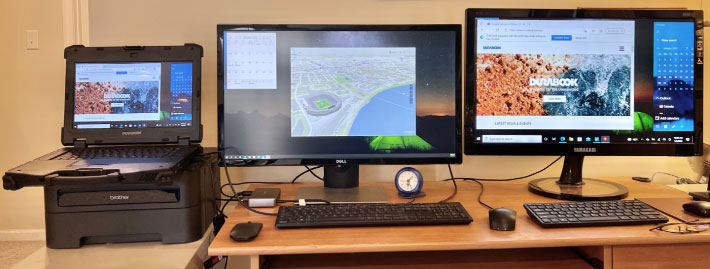
As far as upstream charging goes, the DURABOOK Z14I recognized our Anker 5-in-1 Thunderbolt 4 dock, which can provide up to 85 watts of charging power, as a power supply. The dock started charging the Z14I at a charge rate of up to about 20 watts. After a couple of minutes, however, the computer reverted back to drawing from the battery. After another minute or two, it went back to charging from the dock again. And that repeated itself over and over. Durabook looked into that for us and found that the power output from the dock fluctuates between 60 and 85 watts, and it is when the power output drops down to 60 watts that the Z14I determines the power feed to be insufficient and hence switches back to battery.
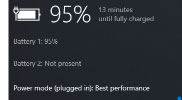 We then connected the Z14I to our larger Anker Thunderbolt 4 12-in-1 dock that can supply 90 watts of upstream charging power. The DURABOOK recognized it as a power source and began charging at up to about 25 watts and, unlike with the smaller dock, didn't go back to battery. With both Anker docks, the Windows power popup showed remaining charging time until full.
We then connected the Z14I to our larger Anker Thunderbolt 4 12-in-1 dock that can supply 90 watts of upstream charging power. The DURABOOK recognized it as a power source and began charging at up to about 25 watts and, unlike with the smaller dock, didn't go back to battery. With both Anker docks, the Windows power popup showed remaining charging time until full.
We also tried Thunderbolt upstream charging with a 30 watt Apple MacBook Air USB-C power supply. That one wasn't acknowledged and didn't charge.
We consider the upstream charging capability of Thunderbolt 4 a valuable feature because, theoretically, it allows charging a laptop with pretty much any USB charger. As is, there may be limitations, and customers interested in upstream charging must make sure their charger or dock is supported.
Fully-rugged
When designing, and now upgrading, the DURABOOK Z14I, Durabook had two goals. One was to give their legacy DURABOOK R8300 a new running mate with contemporary design, functionality, features and premium performance. The other was to meet or beat the fully-rugged laptop competition from Getac, Dell, DT Research and Panasonic and make inroads in market share.
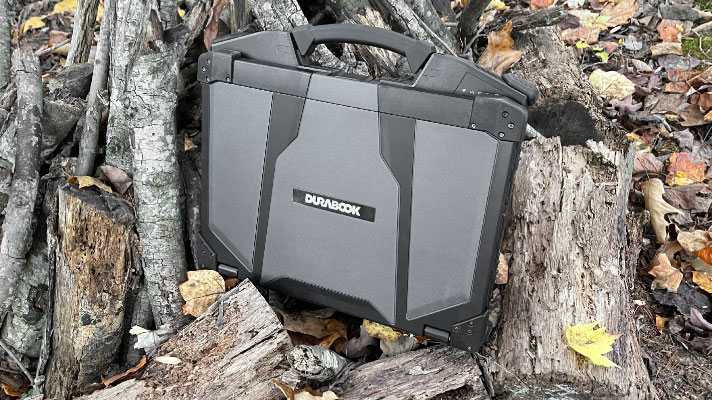
While ruggedness metrics include a variety of tests, two stand out. What kind of a drop can a laptop survive? And how well is it protected against wetness and particulates. The former is measured in feet and testing is performed according to MIL-STD-810H procedures. The latter is expressed in an IP Ingress Protection) rating.
What Durabook did with the DURABOOK Z14I is build it so it can handle 6-foot drops and get an IP65 rating. That's way tougher than semi-ruggeds, and with it the DURABOOK Z14I can meet the major competition head-on.
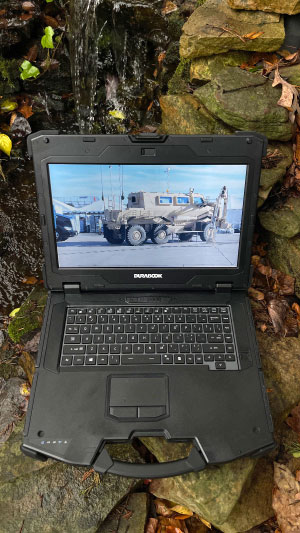 The relevance of the 6-foot drop versus the 4-foot drop mandated by the government Department of Defense standard and the 3-foot drop semi-ruggeds can usually handle is illustrated in the pictures above: when you walk around with a notebook under your arm and you drop it, that's about three feet.
The relevance of the 6-foot drop versus the 4-foot drop mandated by the government Department of Defense standard and the 3-foot drop semi-ruggeds can usually handle is illustrated in the pictures above: when you walk around with a notebook under your arm and you drop it, that's about three feet.
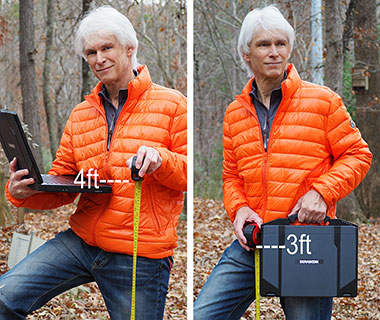 But when you drop it while using it — which almost inevitably happens at some point — that's four feet. Should what is likely to happen be the very limit? No, it's better to have a margin of error. Hence Durabook's insistence on being able to handle six foot drops.
But when you drop it while using it — which almost inevitably happens at some point — that's four feet. Should what is likely to happen be the very limit? No, it's better to have a margin of error. Hence Durabook's insistence on being able to handle six foot drops.
On the sealing front, Durabook claims IP65-level protection for the Z14I. The "6" means complete protection against dust, and the "5" means protection against low pressure water spray spray from all directions. Rain won't even be an issue.
As for the operating temperature range, the Z14I specs claims an impressive -4°F to 140°F (-20°C to 60°C), which means the laptop can be used virtually anywhere.
According to Durabook, the Z14I has been MIL-STD-810H certified for drop, shock, vibration, rain, dust, altitude, freeze/thaw, high/low temperature, temperature shock, humidity, explosive atmosphere, solar radiation, salt fog, and fungus resistance. It also has been MIL-STD-461G certified for conduction, radiation, conducted susceptibility, and radiated susceptibility. We'd like to see these certifications published on the Durabook website so that prospective customers can see the exact testing parameters.
Summary: The DURABOOK Z14I fully-rugged laptop
With the updated second generation of its Z14I fully-rugged laptop, Durabook now has a thoroughly modern tool for customers who require high-performance computing power out there in the field, in vehicles, on the shop floor, or wherever else a tablet or a handheld or even a semi-rugged laptop just won't do. It's a big, attractive, impressive machine with a very bright, reflection-free 14-inch wide-format display, great connectivity, good battery life, and excellent performance.
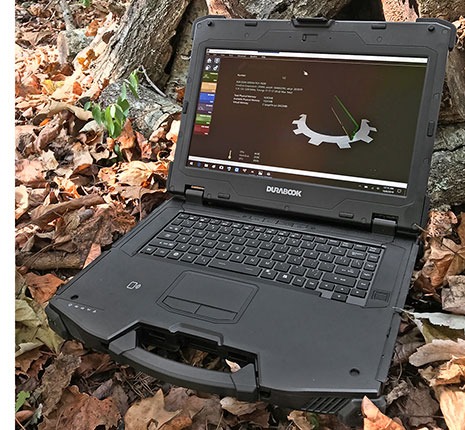 In terms of ruggedness, the fanless DURABOOK Z14I meets or exceeds fully-rugged class standards. The laptop's 6-foot drop spec provides a good safety cushion past most common drop scenarios, and its IP65 ingress protection rating means it can handle anything short of full immersion.
In terms of ruggedness, the fanless DURABOOK Z14I meets or exceeds fully-rugged class standards. The laptop's 6-foot drop spec provides a good safety cushion past most common drop scenarios, and its IP65 ingress protection rating means it can handle anything short of full immersion.
The official US$3,599 starting price of the DURABOOK Z14I is significantly higher than that of the company's semi-rugged laptops, but in line or below that of the fully-rugged competition. Note that DURABOOK computers are built-to-order and available in a wide range of configurations and the choice of many options that can drive up the price.
DURABOOK laptops have always been strong performers, and that tradition carries on with the Z14I. Available with a choice of four Intel 11th generation "Tiger Lake" Core processors, the laptop scored excellent overall benchmark results. Equipped with the standard battery, our review machine scored almost 14 hours in our battery test.
The DURABOOK Z14I has a 1920 x 1080 pixel wide-format 1,000 nits (we measured 1,150 nits) display that controls reflection and glare well. Our review unit came with the optional capacitive multi-touch screen.
Designed for the extreme conditions faced by military, industry, field service personnel, and similar demanding deployments, the DURABOOK Z14I, with its aluminum-magnesium alloy chassis and bottom, large protective bumpers, and exceptionally solid construction should hold up for a long time.
With the DURABOOK Z14I, Durabook has a strong and very competitive offering in the hotly contested market of fully-rugged laptops. And it is a machine that offers exceptional versatility and expandability.
— Conrad H. Blickenstorfer, January 2022
|
DURABOOK Z14I fully-rugged laptop
Specs
|
| Status |
Full review 01/2022
|
| Product type |
Fully-rugged notebook computer
|
| Processor |
Intel 11th gen (Tiger Lake) Core i7-1185G7
Intel 11th gen (Tiger Lake) Core i7-1165G7
Intel 11th gen (Tiger Lake) Core i5-1145G7
Intel 11th gen (Tiger Lake) Core i5-1135G7
|
| CPU speed |
i7-1185G7: 4.80 GHz
i7-1165G7: 4.70 GHz
i5-1145G7: 4.40 GHz
i5-1135G7: 4.20 GHz
|
| CPU Smart Cache |
i7-1185G7: 12MB
i7-1165G7: 12MB
i5-1145G7: 8MB
i5-1135G7: 8MB
|
| CPU Thermal Design Power |
12/28 watts (all)
|
| OS |
Windows 10 Professional
|
| Graphics |
Intel Iris Xe graphics, optional NVIDIA GeForce GTX 1050 MXM
|
| Memory |
8GB to 64GB DDR4-3200MHz in two 204-pin SODIMM sockets |
| Display type |
Transmissive TFT with anti-glare coating and 10-step adjustable backlight OR optional 1,000-nits (1270 nits as tested) sunlight-readable with touch screen and Night Vision mode
|
| Display size and resolution |
14.0"/1920 x 1080 pixel (157 ppi) FHD
|
| Digitizer/Pens |
10-finger capacitive multi-touch
|
| Keyboard |
Waterproof 88-key membrane keyboard, with LED backlight
|
| Storage |
Quick-release main storage 256/512/1TB NVME PCIE Solid State Disk; optional 256GB/512GB/1TB SATA SSD; optional OPAL 2.0 SSD; optional 2nd/3rd storage (SATA SSD)
|
| Multimedia Pocket |
Super Multi DVD-RW Drive OR 2nd Battery Pack OR additional storage (SSD)
|
| Slots |
1 x microSDXC Card, 1 x SIM card, 1 x SmartCard reader, 1 x ExpressCard 54 OR 1 x PCMCIA Type II
|
| Housing |
Aluminum-magnesium chassis with port covers |
| Temperature |
-4° to 140°F (-20° to +60°C)
est: |
| Humidity |
5 to 95% non-condensing |
| Vibration |
MIL-STD-810H tested
|
| Ingress protection |
IP65 |
| Explosive Atmosphere |
ANSI/ISA 12.12.01-2000, Class I, Division 2
|
| EMI |
NA |
| Solar Radiation |
MIL-STD-810H |
| Salt Fog |
MIL-STD-810H |
| Altitude |
MIL-STD-810H |
| Shock: Transit Drop |
MIL-STD-810H, Method 516.6, Procedure IV (26 6-foot drops to plywood over concrete) |
| Certifications |
FCC, DOC+ FCC ID, CE |
| Size (inches) |
14.0 x 11.0 x 2.0 inches (356 x 280 x 50 mm) including carry handle |
| Weight |
7.94 lbs (3.6kg); 8.75 pounds as tested with battery, optical drive, and handle.
|
| Power |
Hot-swappable 6-cell 10.8V, 7,800 mAH 84.2 watt-hour Li-Ion ("16 hrs."), 5-min bridge battery,; optional second 6-cell 10.8V, 4.700 mAH 50.8 watt-hour battery |
| Camera |
Integrated 2-megapixel webcam with privacy shutter
|
| Security |
Intel vPro (per CPU options), TPM 2.0, NIST BIOS compliant, easy removable SSD, Smart Card reader default, Stealth mode, Kensington lock, Night vision mode; optional: fingerprint scanner; RFID reader
|
| Wireless |
Intel Dual Band Wi-Fi 6 AX201 (802.11 ax), Bluetooth 5.2; optional: uBlox NEO-M8N GPS, 4G LTE multi-carrier mobile broadband, RF antenna pass-through for GPS, WWAN, and WLAN
|
| Interface |
1 x USB 3.2 Gen2 Type-A with DP support, 1 x USB 3.2 Gen2 Type-A, 1 x USB 2.0 Type-A, 1 x USB 3.2 Gen2 Type-C, 1 x Thunderbolt 4 Type-C, 2 x RJ45 10/100/1000, 2 x DB9 RS232 serial , 1 x VGA, 1 x HDMI Type-A, audio in/out, 41-pin pogo dock
|
| Price |
Starting MSRP US$3,599 |
| Contact |
Durabook
|
| Website |
DURABOOK Z14I page |
| Brochure |
 DURABOOK Z14I brochure DURABOOK Z14I brochure |
| Warranty |
3-Year DURABOOK 3-D warranty |
| Contact |
Durabook, 48329 Fremont Blvd., Fremont, CA 94538, 510-492-0828 |






